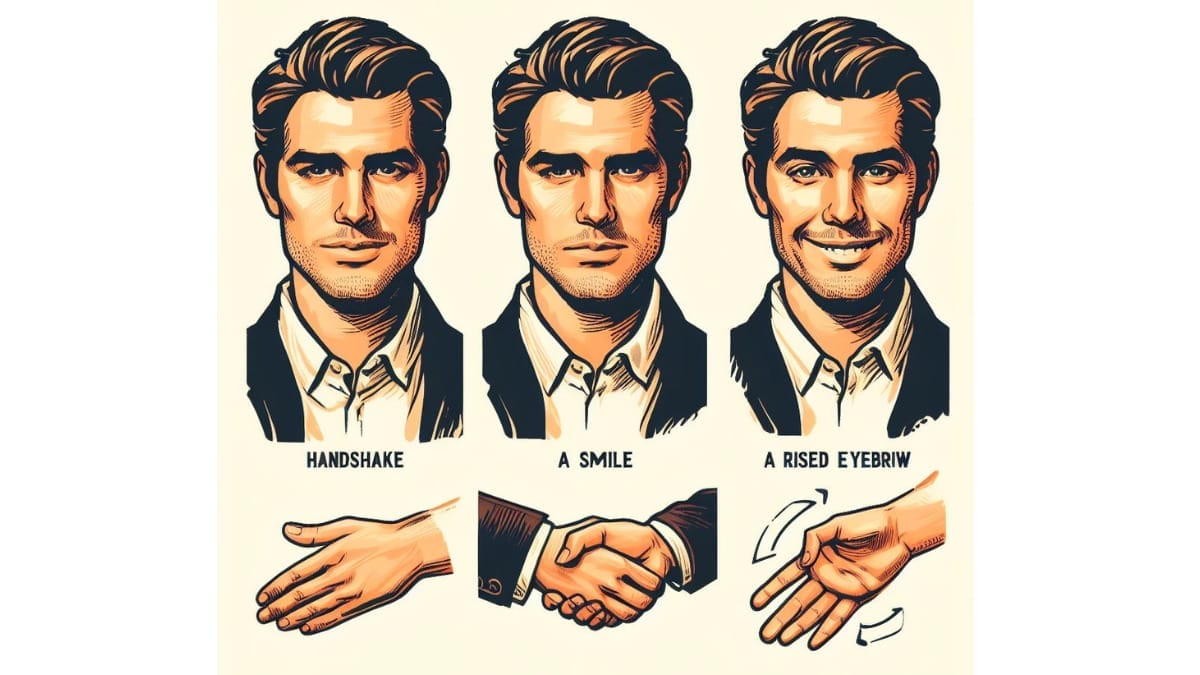Introduction
Imagine you’re in a crowded room, lost in a sea of conversations. Words, sentences, and testimonies swirl around you, growing a symphony of verbal messages. But inside the midst of this linguistic cacophony, something greater profound is going on – a silent dialogue, a dance of unspoken cues that could often say more than words ever could. It’s the language of body language, a form of nonverbal verbal exchange that transcends linguistic limitations.
The way you operate frame language – the subtle shift in your posture, the assured eye contact, the graceful gesture, and the unfiltered facial expressions – could make you look both approachable or distant, confident or insecure. Every twitch, each glance, each tilt of the head is a cue, a piece of the puzzle that reveals what’s going on below the floor.
Have you ever been in a verbal exchange in which a person’s terrible frame language – crossed arms, averted eyes, and an irritating tone of voice – contradicted their words, leaving you uncertain of their actual emotions? Or perhaps you’ve encountered someone with superb frame language – an open stance, a warm smile, and maintained eye contact – making your experience right away at ease.
These days, the significance of frame language is glaring since it impacts our ability to interact, perceive, and understand the environment around us. This journey will delve deeply into the captivating discipline of body language, assisting us to recognize the messages that pass unstated but regularly carry more which means than the phrases we select to use. Join us as we discover the intricacies of nonverbal cues and discover ways to read frame language to apprehend the hidden testimonies within.
So, next time you observe someone, consider, that it’s not just their phrases that display the narrative – their frame language paints an unstated masterpiece that’s ready to be uncovered.
Key Takeaways:
An entertaining journey into the domain of nonverbal communication will provide you with a treasure mine of knowledge and essential insights that will improve both your personal and professional realms. Here are the main points that require your attention:
- Key Elements: Bodily language is typically composed of posture, gestures, facial expressions, eye touch, and physical motion.
- Enhanced Communication: You’ll discover that the words we speak are simply one part of the tale. Understanding the nuances of body language lets you connect on a deeper level, improving your capacity to communicate efficaciously.
- Empowered Relationships: In personal relationships, you’ll benefit from the skills to resolve conflicts, foster consideration, and create stronger bonds. By learning to read the unstated messages, you’ll find the authentic feelings and intentions of those you have interacted with.
- Professional Success: In the professional sphere, the capability to study frame language turns into a powerful asset. Whether it’s acing job interviews, leading groups, or ultimate enterprise deals, your newfound expertise will set you other than the relaxation.
- Detection of Deception: You’ll sharpen your skills in spotting signs and symptoms of deception. By recognizing diffused cues, you may defend yourself from scams, lies, and manipulative situations, making you a greater discerning and informed person.
- Ethical Awareness: Throughout this journey, you’ll also benefit a profound information on the moral considerations surrounding body language. You’ll know how to respect boundaries and use this knowledge responsibly.
- Improved First Impressions: Understanding the importance of first impressions and using fine body language can make your initial interactions extra memorable and impactful.
- Ongoing Mastery: The journey doesn’t cease here. We’ll offer you sources for similarly mastering, encouraging you to hold your exploration of this captivating artwork.

Key Elements of Body Language
Body language is an effective method for speaking without the usage of phrases. Understanding the basic traits of frame language can help you in interpreting others’ unsaid feelings and intentions. Here are some essential components of body language:
| Element | Description |
|---|---|
| Body Movement | The way you move your body can convey a lot about your emotions and intentions. For example, leaning ahead can signal hobby, whilst crossing your palms can imply defensiveness or pain. |
| Posture | Your posture can also reveal your level of confidence and engagement. Standing up directly and maintaining eye touch can convey confidence and attentiveness, while slouching and keeping off eye touch can suggest disinterest or nervousness. |
| Eye Contact | Facial expressions are universal and can reveal a range of emotions, from happiness and surprise to anger and sadness. Smiling can bring warm temperature and friendliness while frowning can endorse displeasure or frustration. |
| Gesture | Using your hands to gesture can add emphasis and clarity to your message. For instance, pointing can indicate a course or a specific item, even as waving your hands can endorse enthusiasm or pleasure. |
| Facial Expression | The way you position your body can also reveal your level of interest and engagement. Facing someone directly can indicate attentiveness and openness while turning away can indicate disinterest or soreness. |
| Body Positions | The way you position your body can also reveal your level of interest and engagement. Facing someone directly can indicate attentiveness and openness while turning away can suggest disinterest or pain. |
Remember that eye contact is likewise critical, as it can assist in establishing belief and sincerity. Facial expressions are accepted, so take note of them when deciphering the feelings of others. Additionally, the use of your hands to gesture can add emphasis and readability to your message.
The Power of Nonverbal Communication
Science Behind It
In an intricate web of communication, nonverbal cues are essential to human contact. We have to first understand the mental foundations that allow us to realize it. Prominent experts including Paul Ekman and Allan Pease have dedicated their professional lives to decoding the secrets and techniques of nonverbal communication.
Ekman’s groundbreaking research delves into the universality of facial expressions. His work has shown that positive expressions, like a grin or a frown, are identified and understood throughout cultures. This highlights the innate nature of nonverbal communication; it transcends linguistic boundaries.
Conversely, Allan Pease has investigated how human brains interpret and absorb nonverbal messages. According to his research, we naturally observe body language and it greatly affects how we view other people.
Universal Nature
Nonverbal communication’s universal aspects are a testament to its power. Regardless of our upbringing or language, some clues are hardwired into our brains to cause specific reactions. Consider it as a universally understood secret language that conveys a great deal without using words.
When you use body language effectively, you tap into this universal communication channel. From a firm handshake to maintaining eye contact, these actions resonate with people on a primal level. They convey confidence, openness, and trustworthiness.

Reading the Face: Decoding Expressions
Facial Expressions
The human face is a canvas of emotions. Facial expressions, whether fleeting microexpressions or more extended displays are windows into our feelings. Gaining an understanding of these indicators may revolutionize both personal and professional relationships.
Think about this: a raised eyebrow can convey astonishment, but a wrinkled brow could suggest misunderstanding. A genuine smile extends to the eyes, creating crinkles at the corners – a telltale sign of happiness. Learning to read these cues helps you navigate social situations with finesse.
Real-life Examples
To illustrate the importance of facial cues, let’s dive into some actual lifestyle scenarios. Imagine a process interview wherein the candidate continues consistent eye touch, smiles definitely, and nods in agreement. Their chances of leaving a positive impression skyrocket.
Conversely, think of a situation where someone avoids eye contact, furrows their brow, and displays a tense posture during a negotiation. These negative body language signals can hinder effective communication.
Now, picture a public speaker who exudes confidence through their relaxed body language. Their audience is more likely to be engaged and open to their ideas. It’s a testament to how body language in communication can be a powerful tool.
Body Language in Various Aspects of Life
The influence of body language extends far beyond personal interactions. Let’s explore how it plays a role in different areas of life:
In the Workplace
In the professional arena, body language is often unconscious yet crucial. A speaker who gives off negative body language during a presentation, like crossing their arms or fidgeting, can undermine their message. On the contrary, a confident posture and open body language illustrate authority and competence.
Personal Brand
Your body language contributes significantly to your non-public logo. Maintaining superb body language shows that you’re approachable, open to new ideas, and confident in your capabilities. This impression can open doors and create opportunities.
Unspoken Emotions
In the intricate dance of human interaction, body positions, and gestures convey countless emotions without saying a word. Just as a chimpanzee in a forest communicates commitment in more ways than one, your body language can reveal your intentions and emotions.
The Power of Nonverbal Signals
Effective communication is not limited to the words you speak. It involves understanding the powerful language of nonverbal signals. Your body language can assist you in information and deciphering what the character you’re communicating with is pronouncing, even if their phrases would possibly tell an exclusive tale.
In social settings, it’s vital to be cautious of how you operate your body language. A good posture will supply the impact that someone is open, attentive, and assured. The proper quantity of eye touch indicates that you are engaged and inquisitive about the verbal exchange.
Gestures are another thing of nonverbal verbal exchange. They frequently show up without wondering. You would possibly use your fingers to emphasize a point or explicit enthusiasm even as speaking. These gestures upload depth and meaning to your words, making your conversation greater powerful.
Understanding Body Language: Tips and Tricks
Here are a few beneficial guidelines for improving your daily contacts and conversation talents:
- Pay attention to body language: Listen now not only to what a person is pronouncing but also to the signals their frame is sending.
- Pay interest to frame language: Pay attention not just to what people say, but additionally to the messages their bodies speak.
- Use facial expressions correctly: Keep in thoughts that facial expressions are popular. A smile, for instance, is recognized internationally as a signal of happiness.
- Be careful of how you use gestures: While gestures can enhance your communique, using them inappropriately can result in misunderstanding.
The Impact on Your Brand
Your non-public brand is a valuable asset, and body language performs a sizeable function in shaping it. Just as your phrases convey your thoughts, your nonverbal cues talk volumes approximately who you are. Whether you’re arguing or talking animatedly, your frame language is a silent associate inside the communique.

The Body Talks: Posture and Gestures
In the problematic tapestry of human verbal exchange, the language we speak with our our bodies regularly conveys extra than our phrases ever may want to. This silent talk, called frame language, plays a pivotal role in our every day interactions, from the place of work to social gatherings. It is the unsung hero of powerful communique, revealing our feelings, attitudes, or even the truth or deception that hides beneath the surface.
The Language of Posture: Explore how posture reflects confidence and attitude.
The Power of Positive Body Language
Picture a confident individual entering a room. What do you see? Their head held high, shoulders back, and a warm, open expression. This is the language of high quality body language, and it speaks volumes. It tells others that this character is self-assured, approachable, and ready to interact in meaningful communication. Positive frame language exudes self belief and fosters an environment of believe and cooperation.
- Stand tall and immediately, shoulders again.
- Maintain eye contact to show you’re engaged.
- Use open hand gestures to appear more welcoming.
The Pitfalls of Negative Body Language
Conversely, bad body language can preclude powerful communique. Slouched shoulders, prevented eyes, and crossed arms send signals of soreness, insecurity, or defensiveness. Understanding how to read body language, especially negative cues, is vital in deciphering the true feelings of those around us.
- Crossing your arms can signal defensiveness.
- Avoid excessive fidgeting or nervous gestures.
- A weak handshake can convey a lack of confidence.
Gestures and Hands
In the grand symphony of nonverbal verbal exchange, our fingers take center degree. The way we use gestures and our frame language is important in conveying our mind and feelings.
The Expressive Power of Hand Movements
When we emphasize our words with expressive hand movements, it adds depth and nuance to our verbal communication. A well-timed gesture can illustrate a point, express enthusiasm, or even reassure others. This type of body language is a powerful tool in our communication toolkit.
Reading the Language of Others
Understanding the body language of others involves paying attention to their hand movements. Are they gesturing naturally and spontaneously, or do their actions seem forced and rehearsed? These observations provide insights into whether the speaker is being genuine or attempting to conceal the truth.
Lies and Truth: Detecting Deception
Unmasking deception is a skill that’s as antique as time. In the realm of nonverbal communique, it’s all approximately reading the diffused signs that betray dishonesty.
Signs of Deception
People can also lie with their phrases, however their body language regularly tells a distinct tale. For instance, someone who averts their gaze fidgets nervously, or affords indistinct solutions is probably concealing the truth. Learning to apprehend these signs of deception may be a valuable asset in private and expert existence.
- Inconsistent facial expressions can indicate deception.
- Watch for microexpressions that flash across the face.
- Avoiding eye contact might signal dishonesty.
Case Studies: Explore famous cases where body language reveals hidden truths or lies.
Let’s delve into some captivating case studies where body language played a pivotal role in uncovering concealed facts:
Case 1: The Political Speech
In a high-stakes political speech, the speaker’s phrases appeared assured and assertive. However, an astute frame language professional noted diffused symptoms of tension – a trembling hand, prevented eye touch, and a disturbing posture. These body language cues indicated that the speaker wouldn’t be as confident in their statements as they appeared.
Case 2: The Witness Stand
During a criminal trial, a key witness provided a compelling testimony. Yet, keen observers noticed that their body language conflicted with their spoken words. The witness frequently looked down and avoided eye contact with the jurors. This negative body language suggested that the witness might not be entirely truthful, casting doubt on their testimony.
In both of these instances, the importance of body language in verbal exchange is clear. It illustrates how our nonverbal cues can either help or undermine the phrases we use.
Application in Real Life
Words are not the only actors on stage in the complex dance of human connection. Our bodies also convey a complex web of feelings, ideas, and intentions. Gaining a knowledge of this nonverbal language may also assist you in navigating lifestyles more skillfully, enhancing your relationships, and being successful professionally. So, permit’s delve into the captivating international of body language and find out how it may be your secret weapon in each of your personal and expert lifestyles.
Enhancing Relationships
In the world of personal relationships, the unspoken language of the body can both enhance bonds or drive a wedge between individuals. Here are some key insights into how frame language can be harnessed for the better:
1. Body Language: The Silent Communicator
The importance of frame language in conversation cannot be overstated. It enhances your phrases, conveying feelings, rationale, and sincerity. By tuning into the unspoken cues, you can bridge gaps, display empathy, and reinforce connections.
2. Reading Between the Lines
In the place of the job, frame language includes more than simply hand and facial motions. Gaining knowledge of the extra nuanced factors—like posture, eye contact, and private area—will help you construct accept as true, and interpret hidden alerts.
3. Using Body Language to Your Advantage
Becoming a body language expert isn’t reserved for the few; all people can learn to use nonverbal verbal exchange to their benefit. Whether you’re in a negotiation or surely having a heart-to-coronary heart conversation, getting to know the artwork of frame language can cause extra hit outcomes.
4. Types of Body Language
People’s body language may be classified into various sorts, from open and alluring to closed and shielding. Recognizing these cues lets you adapt your conversation style to connect greater successfully.
5. The Confidence Connection
Body language illustrates your confidence level. Maintaining positive body language suggests self-assuredness, which can be contagious. The importance of body language lies in the manner it influences perception and can even affect your self-esteem.
6. The Subtle Language
Language in communication is often verbal, but the more powerful, intricate, and often unconscious communication takes place through body language. Mastering this art is like discovering a hidden treasure trove of human interaction.
7. The Window to the Soul
Eye contact is also important in the realm of body language. It signifies engagement, honesty, and interest. Keeping your body language in sync with your words is crucial in maintaining the flow of a conversation.
Professional Success
In the professional arena, body language can make or break opportunities. Job interviews, workplace dynamics, and conflict resolution all dance to the tune of nonverbal communication.
- Acing Interviews: Picture this: You walk into a job interview with confidence, a firm handshake, and maintain eye contact. Your potential employer immediately perceives you as self-assured and competent. The job could be yours.
- Negotiation Skills: In negotiation, body language speaks volumes. It can emphasize your points, demonstrate confidence, and seal the deal.
This is the hidden curriculum in the job market – understanding and mastering body language to your advantage.

Ethical Considerations
Respect and Boundaries:
While harnessing the power of body language, it’s essential to navigate this territory ethically. Understanding personal boundaries and consent is paramount:
1. Ethical Interaction
Respect is a cornerstone of ethical communication. Acknowledge personal boundaries, and be aware that not everyone may feel comfortable with close physical contact or intense eye contact. Consent is key.
2. The Fine Line
The importance of being careful when interpreting body language cannot be overstressed. It’s easy to misread cues, so always ask for verbal confirmation when consent and boundaries are involved.
Potential Misuse
Tremendous power with a tremendous deal of responsibility. Abusing your understanding of body language can have severe repercussions:
1. The Dark Side
Understanding body language can indeed be powerful, but it should never be used to manipulate or deceive others. Misuse can harm relationships and erode trust.
2. The Balancing Act
Balancing your newfound knowledge with ethical considerations is crucial. Always remember that transparency and honesty should guide your use of body language skills.
My Journey into the World of Body Language
In my own life, I’ve seen the significant influence that understanding nonverbal communication can have, and I’d want to relate a personal experience that exemplifies its importance.
Some time back, I attended a networking conference. It was a busy evening when people from various fields gathered, chatting away. As a shy person, such types of meetings scared me much though they were necessary in helping my career progress. In a sea of unfamiliar faces, however, I felt uncomfortable and lost.
That’s when I recognized him: a seasoned businessman, well-dressed and friendly. He was conversing with a small group, and his body language shone out in the throng like a beacon of hope. His stance was wide, with a small forward lean, and his arms relaxed at his sides. He kept constant eye contact with people he was conversing with, nodding in agreement or empathy as they expressed their ideas.
I approached him because of his demeanor and mannerisms rather than his words. The approachability, confidence, and attentiveness he conveyed through his non-verbal cues were magnetic. He welcomed me with an open gesture and a warm grin as soon as I entered the talk, which put me at ease right away.
During the evening, I saw that his skill in body language let him easily connect with people. He could understand the situation in the room, adapt to what the conversation needed, and make folks feel important and listened to. Through his gestures, expressions, and posture, he conveyed authenticity and built trust within minutes.
I was deeply affected by this encounter. It helped me realize that good body language communication involves more than simply reading others’ nonverbal signs; it also involves employing your own. I began getting to know body language, analyzing works via specialists like Paul Ekman and Allan Pease, and gaining self-belief in my capability to interact with others.
As I honed my information of frame language, I observed it to be an essential tool not simply for networking but also for enhancing my private relationships and professional interactions. The ability to detect deception, resolve conflicts, and convey empathy through non-verbal communication became invaluable skills in my journey.
In conclusion, this personal event ignited my passion for understanding body language and its profound importance. It showed me that there is a quiet language that communicates volumes behind the words we say. Reading body language is more than expertise; it’s far a doorway to deeper connections, better communication, and greater fulfillment in our non-public and expert lives.
FAQs: Why is it important to read body language
How can understanding and using body language in the workplace significantly improve your daily interactions and overall communication skills?
Understanding and the use of frame language inside the place of business performs a critical position in enhancing your day-by-day interactions and typical communication abilities.
Human beings additionally use frame language as part of the communique technique, regularly unconsciously. When a speaker gives off negative body language, it can disrupt the communication flow, impacting your brand and the quality of your interactions.
To improve your communication, it’s important to be careful about the signals you are receiving and sending through your body language, ensuring that your body remains relaxed and your gestures without thinking are in line with your words.
What are the most common types of body language, and how can recognizing them help you develop positive body language for more effective communication?
The most common types of body language are powerful communication signals. Recognizing and using body language can help you develop positive body language, which is dominant for most people.
This nonverbal communique is important in preserving the glide of the communique and conveying a friendly and approachable demeanor. By studying and the usage of frame language effectively, you can considerably improve your everyday interactions and the exceptional of your relationships.
Why is it important to study frame language in conversation, and the way can spotting unspoken cues beautify your communique skills and relationships?
It is important to read body language in communication because communication is often unconscious, and body language makes up a crucial part of it. Understanding and decoding unspoken cues assist us in understanding and responding to the emotions and intentions of others.
The way human beings also use body language can greatly affect the way the communication process unfolds, either positively or negatively. Recognizing these cues complements your communication skills and strengthens your relationships.
Could you percentage some body language pointers that humans can use to avoid poor frame language and as a substitute, use frame language to convey a wonderful and approachable demeanor of their day-by-day interactions?
To avoid negative frame language and convey a positive and approachable demeanor in your everyday interactions, you should be conscious of the alerts you’re sending. The process of communication is impacted by the way you use body language.
Remember, you need to improve your body language; otherwise, your gestures and expressions will contradict your oral message. That said, keep in mind, that folks often misinterpret gestures and hence you’d better be conscious about yours.
In what ways does the importance of body language extend beyond words, and how can individuals use body language to improve their daily interactions and the quality of their relationships?
The importance of body language extends beyond words, affecting the way we connect with others. It is an important nonverbal aspect of communication that influences your brand and how you are perceived. The way human beings also use body language is closely tied to how we listen to words.
By being aware of how body language also impacts your interactions, you can consciously improve your daily interactions and maintain a strong, powerful, and positive communication process.
Conclusion
Acquiring the ability to understand and utilize body language is akin to obtaining a superpower in a society where nonverbal cues frequently carry greater weight than spoken words. The main conclusions are as follows:
- The use of body language in communicating is essential.
- The importance of body language extends to relationships, professional success, and personal growth.
- Understanding and respecting personal boundaries and consent is crucial.
- Misusing frame language can result in ethical dilemmas.
As you embark on your journey of mastering frame language, recall that it’s a talent that evolves through the years. Now that you’ve glimpsed the energy of frame language, it’s time to harness it for your benefit. In non-public relationships and expert endeavors, the mastery of this silent communicator could make all of the difference.

Sarah Andrews’ work on relationships is informed by a breadth of experience and a strong interest in human nature. Sarah, who holds a Psychology degree and has a good eye for nuances, delves into the complexity of communication and emotion, delivering insightful insights for readers seeking personal growth and emotional pleasure. Sarah hopes that her empathic approach and insightful suggestions will motivate readers to understand themselves and their relationships better.
